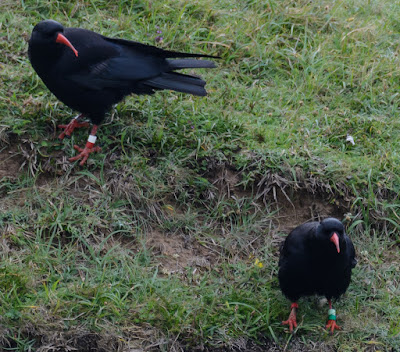- Pair A has produced four juveniles. These birds are all without rings. This family is still sticking pretty close to the nest site and is quite difficult to observe. This will change over the next few days and they will make their presence very obvious.
Pair A defending their territory near to where the juveniles are hidden.
- Pair B has produced three juveniles. One of the adults is ringed: Left: green, red; Right: metal. The green ring stands out and is easy to see with binoculars; the others are tricky without a photo. The other adult is not ringed, but has a distinctive notch in the tail, visible in flight.
Two of the three juveniles were ringed in the nest. Both ringed birds have a metal ring and a large striped mauve and white ring on the right leg. On the left leg one bird has yellow, green; the other has yellow, pale (lime) green. These rings can be seen quite easily with binoculars, so this family is very easy to identify. The third juvenile has no ring. This family is already very active, roaming noisily over about a kilometre of coastline. If you spend an hour or so in the area they will be difficult to miss.The ringed adult telling me it's time I left the area, in late May.One of the ringed juveniles of Pair B.The other ringed juvenile of Pair B. - Pair C has produced three juveniles, which left the nest this morning. Both adults are ringed. Adult 1: Left: white, red; Right: metal. Adult 2 : Left: lime, green; Right: red. These rings are easy to see with binoculars, making this pair easy to identify. If you get a close view, Adult 1 has distinctive crossed mandibles, which do not impair its ability to feed, it seems. All three juveniles of this pair are not ringed. As these birds left the nest only this morning, they are currently very difficult to observe because the adults, having enticed them out of the nest, immediately guided them to a very well-hidden location which it is impossible to view. This will change over the coming days and they will roam around as a family group in the same way as the family of Pair B.
Pair C near the nest site last year. Note the crossed mandibles of Adult 1.
If you do come to see these birds you will also be treated to three pairs of breeding Wheatears (two pairs feeding young today). The male and female of one pair, with food for the nestlings, photographed this morning:
This has also been a good year for Stonechats, with at least four pairs fledging young in the same stretch of coastline where the Choughs breed. There are seven pairs of Fulmars on ledges showing breeding behaviour, but I haven't seen an egg yet, so maybe not this year! But there's plenty to admire in the Fulmars' flying, anyway:
Both taken on June 15 in one of the Chough territories.











1 comment:
Very interesting - glad that the Gower choughs are doing so well!
Post a Comment